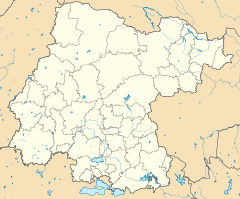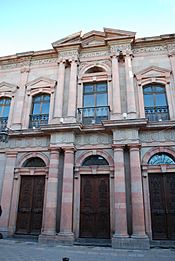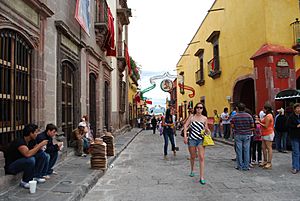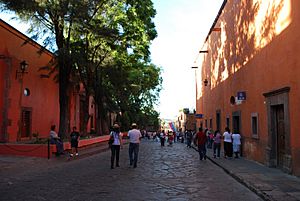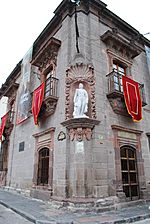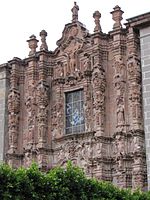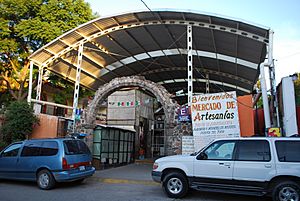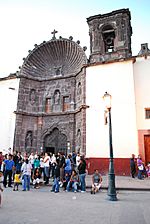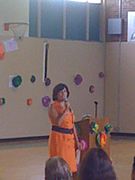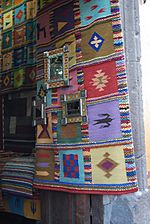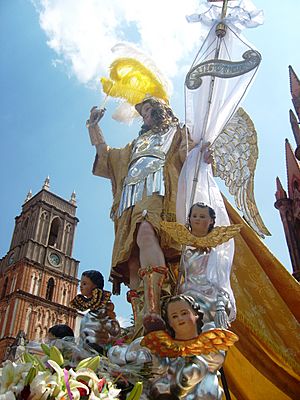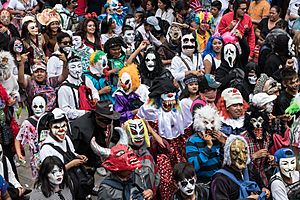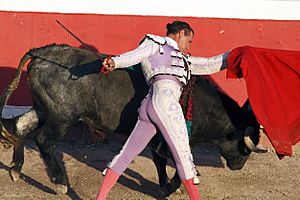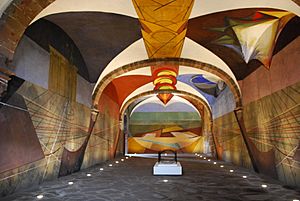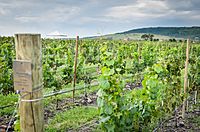San Miguel de Allende facts for kids
Quick facts for kids
San Miguel de Allende
|
|||
|---|---|---|---|
|
City
|
|||
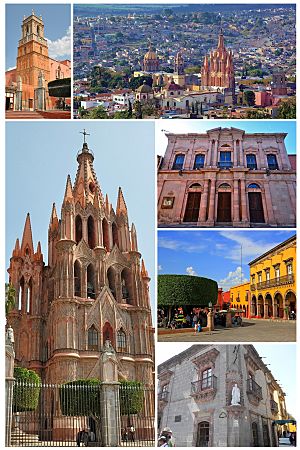
From top to bottom:
Left: - Inmaculada Concepcion Temple - La Parroquia de San Miguel Arcángel Right: - La Parroquia and downtown San Miguel de Allende - Angela Peralta Theater - Jardín Allende - San Miguel de Allende Historic Museum |
|||
|
|||
| Nickname(s):
El Corazón de México
|
|||
| Motto(s):
Hic Natus Ubique Notus
|
|||
| Country | Mexico | ||
| State | Guanajuato | ||
| Founded | Pre-1541 | ||
| Municipal Status | 1811 | ||
| Area | |||
| • Municipality | 1,554 km2 (600 sq mi) | ||
| • Seat | 24.27 km2 (9.37 sq mi) | ||
| Elevation
(of seat)
|
1,900 m (6,200 ft) | ||
| Population
(2020 census)
|
|||
| • Municipality | 174,615 | ||
| • Density | 112.36/km2 (291.02/sq mi) | ||
| • Seat | 72,452 | ||
| • Seat density | 2,985.2/km2 (7,731.8/sq mi) | ||
| Time zone | UTC−06:00 (Central Standard Time) | ||
| Postal code (of seat) |
37700
|
||
| Area code(s) | 415 | ||
| Demonym | sanmiguelense | ||
| Website | [1] | ||
| Official name: Protective town of San Miguel de Allende and Sanctuary of Jesús Nazareno de Atotonilco | |||
| Type: | Cultural | ||
| Criteria: | ii, iv | ||
| Designated: | 2008 (32nd session) | ||
| Reference #: | 1274 | ||
| Region: | Latin America and the Caribbean | ||
San Miguel de Allende is a famous city in Guanajuato, Mexico. It's located in the eastern part of the state. The city is about 274 kilometers (170 miles) from Mexico City.
Its name comes from a friar named Juan de San Miguel from the 1500s. It also honors Ignacio Allende, a hero of Mexican Independence. He was born in a house right in the city's main plaza.
San Miguel de Allende was very important during the Chichimeca War (1540–1590). In this war, the Chichimeca people fought against the Spanish Empire. Today, a historic part of the city is a World Heritage Site. This means it's a special place recognized by UNESCO for its history and beauty. Thousands of visitors and new residents come here every year.
In the early 1900s, the city was almost empty after a sickness. But then, artists from other countries discovered its beautiful old buildings. They started art schools like the Instituto Allende. This made San Miguel famous, attracting artists like David Alfaro Siqueiros.
Many foreign art students came, especially US soldiers after World War II. They used a program called the G.I. Bill to study. Since then, many people from the US, Canada, and Europe have moved here. This changed the city's economy. Now, it focuses more on tourism and serving foreign residents.
In 2008, UNESCO named the "Protective town of San Miguel and the Sanctuary of Jesús Nazareno de Atotonilco" a World Heritage Site. This includes San Miguel's old center and the nearby Sanctuary of Atotonilco. The historic center of San Miguel has many well-preserved buildings from the 1600s and 1700s.
Contents
San Miguel de Allende History
How San Miguel de Allende Started
Before the Spanish arrived in the 1500s, San Miguel was a native village called Itzcuinapan. A small church was built there by Miguel Palanca. He named the Spanish town after the Archangel Michael.
However, the Spanish tried to take over the land and its people. This made the native Chichimeca people fight back. In 1551, a Chichimeca group called the Guamare attacked Spanish camps. Because of these fights and water problems, the Spanish moved the town.
The town was officially restarted in 1555. This was done by Bernardo Cossin and a native leader, Fernando de Tapia. The new spot was better for defense and had fresh water springs.
The Colonial Period
By the mid-1500s, silver was found in nearby Guanajuato and Zacatecas. A main road connecting these silver mines to Mexico City went through San Miguel. Native attacks on travelers continued, making San Miguel an important military and trade spot. This led to the 40-year Chichimeca War.
The Spanish government gave land and animals to people who settled here. They also gave native groups some self-rule and excused them from taxes. San Miguel became a mix of Spanish, native, and later Criollo cultures.
Over time, major roads connected San Miguel to other mining towns. Serving travelers and supplying the mines made the town rich. Making textiles (like cloth) was a big industry. People here say the serape (a type of blanket) was invented in San Miguel.
By the mid-1700s, the city was at its best. Many of its grand houses, palaces, and churches were built then. Most of these buildings are still standing today. San Miguel was one of the most important and rich towns in New Spain. It had a population of 30,000 people. For comparison, Boston had 16,000 people and New York had 25,000 at that time.
The Fight for Independence
The city became less important in the early 1800s because of the Mexican War of Independence. However, it played a key role at the start of this war. Two important war figures, Juan Aldama and Ignacio Allende, were born here.
They were part of a secret plan against the Spanish government. When the plan was discovered, a warning reached Miguel Hidalgo y Costilla and Allende. This led Hidalgo to start the war with his famous "Grito de Dolores" (Cry of Dolores) on September 15-16, 1810.
The rebel army first came to San Miguel. They stopped at a religious place in Atotonilco nearby. Hidalgo took a flag with the Virgin of Guadalupe from here. Then, the army entered San Miguel to name officers and free prisoners. San Miguel was the first Mexican town to become independent from Spain.
After the war, the town's economy suffered, and its population went down. This continued for most of the 1800s. In 1826, the town was declared a city. Its name was changed to San Miguel de Allende to honor Ignacio Allende.
There was some economic improvement in the late 1800s. Dams, aqueducts, and railroads were built. Farming also improved. But then, mining ended in Guanajuato. Between this and the start of the Mexican Revolution, San Miguel almost became a ghost town.
To save it, the Mexican government declared San Miguel a "Historic and Protected Town" in 1926. This helped keep its old colonial look.
From the 1900s to Today
In 1937, American artist Stirling Dickinson arrived. He helped make San Miguel famous for art. In 1938, the first art school, Escuela de Bellas Artes, was started in an old convent. This school still exists today.
In the 1940s, Dickinson also helped start the Instituto Allende. Both schools became popular after World War II. Many US veterans came to study art here. This made the town's reputation as an art center grow. More artists and writers, like David Alfaro Siqueiros, came to teach. This led to new hotels, shops, and restaurants opening.
Since then, San Miguel has continued to be a cultural and international place. It became known for its bohemian (artistic and free-spirited) vibe in the 1950s. Famous actor Cantinflas helped promote the area.
Today, the town is quite popular and can be expensive. Its beautiful colonial buildings have created a busy real estate market.
In July 2008, UNESCO declared the city and the nearby sanctuary at Atotonilco a World Heritage Site. This was because of its well-preserved colonial architecture and its important role in Mexico's history.
People of San Miguel de Allende
The town and area have grown since foreigners started arriving in the 1940s. The population grew a lot between 1980 and 2000. As of 2005, the population was about 139,297 people.
Many people in the area live in small rural communities. The biggest population center is the city of San Miguel de Allende itself, with about 59,691 people.
These smaller communities are home to native groups, mainly Otomi and Nahua people. The Otomi are the largest group. However, only a small number of people speak a native language.
Most people (96%) practice Catholicism. The city has several higher education schools. It also has bilingual schools that follow the American education system.
Famous Places in San Miguel de Allende
Historic City Center
The historic center of San Miguel is a special area recognized by the government and UNESCO. It covers about 43 hectares (about 106 acres).
At the city's entrance, you'll see statues of heroes like Ignacio Allende and Miguel Hidalgo. The historic center looks much like it did 250 years ago. The streets are mostly straight, but some curve because of the hills. You won't find parking meters, traffic lights, or fast-food restaurants here.
The roads are lined with old colonial homes and churches. Most buildings are homes, not grand monuments. They have beautiful courtyards and detailed designs. The houses are painted in bright colors, with bougainvillea flowers hanging down. Many have iron-grated windows. Larger buildings have big entrances where horses and carriages used to pass.
The Jardín Allende (Allende Garden) is the city's main plaza. It's a place for music concerts and other fun activities. It has pretty landscaping and iron benches. It's a popular spot for people to gather and relax.
Inside the historic center, there are thousands of doors. Behind them are many courtyards of different sizes. Many have been restored to their old colonial look. They have colorful walls and windows with handmade ironwork. These courtyards were private gardens, safe from dust and crime.
The city is known for its narrow cobblestone streets that go up and down hills. It's a small city, and it's safe to walk the streets at night. Many magazines have called it one of the best places to retire. Famous people like Jose Guadalupe Mojica have lived here. You can also see native Otomi and Nahua people who come from nearby villages to trade.
Since the 1920s, efforts have been made to protect the historic center. The government made it a national monument. This means all new buildings must match the colonial style. A local group also helps keep the city's charm. The World Heritage Site status adds even more protection.
About half of the old colonial buildings are now businesses. These include stores, restaurants, art galleries, and hotels. There are no strict rules about where homes and businesses can be. So, you'll find them mixed together. The city has many restaurants, unique shops, and art galleries. There are also many bars and nightclubs.
In 2010, the Hotel Matilda opened. It was the first modern building in the historic center. Its design is modern, but its outside wall matches the colonial style.
The oldest part of the city is the El Chorro neighborhood. This is where San Miguel was moved to in 1555. The name Izcuinapan means "place of dogs" in the native language. Legend says dogs led Juan de San Miguel to a spring here. This area is home to the main church and an older church.
La Parroquia de San Miguel Arcángel is the city's main church. It's unique in Mexico and a symbol of the city. Its two tall, neo-Gothic towers can be seen from almost anywhere. The church was built in the 1600s. The current Gothic front was added in 1880 by Zeferino Gutierrez. He was a bricklayer and self-taught architect. People say he got his ideas from postcards of Gothic churches in Europe.
In front of the church is a small area with an iron fence. There's a statue dedicated to Bishop José María de Jesús Diez de Sollano y Davalos. The San Rafael or Santa Escuela Church is next to the main church. It was founded in 1742. Its bell tower has a Moorish (North African and Spanish) style. Legend says this older chapel was where the first Christian ceremony in San Miguel took place.
Inside the main church, you can still see the original 1600s design. However, many decorations were lost when the church was robbed over time. One important item is the "Señor de la Conquista." It was made from cornstalk paste by native people. The room where priests prepare has a painting of the town's founding. There's a small crypt (underground room) under the altar. It holds the remains of former bishops and important people. It's open to the public only once a year, on November 2, Day of the Dead.
In front of the church is the Plaza Allende, also called Jardin Principal (main garden). It's designed in a French style with iron benches and laurel trees. It's a popular place to relax. Bands often play music there on weekends. Other important buildings, like the Ignacio Allende House, are also around the garden.
The Centro Cultural Ignacio Ramirez is also known as Escuela de Bellas Artes or El Nigromante. It's in an old convent. The convent and church were founded in 1775. The convent closed later and was empty until the mid-1900s. The Escuela de Bellas Artes was started here in 1938. This school helped attract American students who came to study art.
Today, the cultural center is part of a national art institute. Locals call it "Bellas Artes." It has two floors around a very large courtyard with a fountain. It hosts art shows and has classrooms for drawing, painting, sculpture, and dance.
One part of the old convent has a mural by David Alfaro Siqueiros. The center also has a museum, an auditorium, and art galleries. Next to the cultural center is the Inmaculada Concepcion Church, known as Las Monjas (The Nuns). It was part of the convent. Its beautiful dome was added in 1891. It was inspired by a famous building in Paris.
The Casa de Allende (Allende House) museum was the home of Ignacio Allende. He was a key figure in the Mexican War of Independence. The house was built in 1759. The museum inside is called the Museo Histórico de San Miguel de Allende. It tells the history of the local area.
The museum shows how the town was founded and its role in important trade routes. It also has exhibits about Ignacio Allende's family and his part in the War of Independence. Some rooms look just as they did when he lived there. The museum was updated and reopened in 2009.
The Casa del Mayorazgo de la Canal was built in the 1700s. It was the home of the wealthy De la Canal family. It was one of the most important buildings in the city. Its design was inspired by French and Italian palaces. Today, it's the Casa de Cultura de Banamex. It has old paintings and hosts different art shows.
On the north side of the Jardin Principal is the municipal palace. It was first built in 1736. This building has been damaged and rebuilt many times. It's famous for being the place where the first "independent" city government was formed. This happened on September 17, 1810, led by Miguel Hidalgo and Ignacio Allende.
Close to the Nuestra Señora de la Salud and Oratorios de San Felipe Neri churches is the Plaza Civica or Civic Plaza. This plaza was built in 1555 and was meant to be the town's original center. Today, it has a statue of Ignacio Allende on a horse.
The San Francisco Church was started in 1778 and finished over twenty years later. Its front is very detailed with stone figures and columns. The bell tower was added in 1799 in a different style by architect Francisco Eduardo Tresguerras.
The Biblioteca Pública (public library) is a community center for the many foreigners living in San Miguel. A Canadian woman started this library to help local children. It's the largest privately funded public library in Mexico. It has the second-largest collection of English books. The library has a café and offers tours. It also prints a newspaper in two languages. It helps local youth with scholarships and free English and computer classes.
To the south of the historic center is Parque Juárez (Juarez Park). This park was created in the early 1900s. It has fountains, pools, iron benches, old bridges, and walking paths. There's a playground and basketball court for children. The park has many local plants and trees. You can often see herons near the water. Sometimes, local musicians play concerts here at night.
The Mercado de Artesanias is an important market. It sells many handmade items like wool, brass, paper mache, and blown glass crafts. You'll often see frogs on the items, as Guanajuato means "place of frogs." This market is in a narrow alley behind the main fruit and vegetable market. The items here are often more real and cheaper than those near the main square.
The Institute Allende is in a huge complex that was once a large estate. The old house has courtyards, a private chapel with old paintings, an art gallery, and a restaurant. In 1951, it became an art institute. It offers classes in silverwork, ceramics, and Spanish. Many students come here each year.
The Angela Peralta Theater was built for opera. It opened in 1873 with a performance by a famous singer, Angela Peralta. Today, it hosts many music events, like the Jazz Festival.
Other cultural places include the Otra Cara de Mexico, which has many traditional Mexican masks. There's also a bullring and an old train station. The Museo de la Esquina is a museum for traditional toys from all over Mexico.
Outside the City Center
The Oratorio de San Felipe Neri Church was built in 1712. Its front is made of pink sandstone with lots of plant decorations. The inside has paintings by Miguel Cabrera. One special room is a chapel dedicated to the Virgin of Loreto. It's a copy of a famous church in Italy and is richly decorated with gold.
The Nuestra Señora de la Salud Church was built in the 1700s. Its main entrance is in a Spanish Baroque style. The inside has paintings by Agapito Ping. This church was once the chapel for the Colegio de San Francisco de Sales next door. Both Ignacio Aldama and Ignacio Allende went to school here.
The El Charco del Ingenio Botanic Garden has many plants, including cactuses, from the area.
Outside the city, you can find an ancient Otomi site called Cañada de la Virgen.
San Miguel de Allende Geography
The city of San Miguel de Allende is in the state of Guanajuato. It's about 74 kilometers (46 miles) east of Guanajuato City. It's also about 40 kilometers (25 miles) northwest of Querétaro.
The city is located where four small rivers meet. One of these, El Obraje, collects water in a dam. Several dams in the area help control rivers and manage water. The most important is the Ignacio Allende Dam.
Climate in San Miguel de Allende
| Climate data for San Miguel de Allende (1951–2010) | |||||||||||||
|---|---|---|---|---|---|---|---|---|---|---|---|---|---|
| Month | Jan | Feb | Mar | Apr | May | Jun | Jul | Aug | Sep | Oct | Nov | Dec | Year |
| Record high °C (°F) | 34.5 (94.1) |
35.5 (95.9) |
38.0 (100.4) |
39.0 (102.2) |
39.6 (103.3) |
39.0 (102.2) |
36.8 (98.2) |
36.0 (96.8) |
37.0 (98.6) |
37.0 (98.6) |
34.5 (94.1) |
32.5 (90.5) |
39.6 (103.3) |
| Mean daily maximum °C (°F) | 23.0 (73.4) |
25.2 (77.4) |
28.5 (83.3) |
30.2 (86.4) |
30.7 (87.3) |
29.1 (84.4) |
27.2 (81.0) |
27.2 (81.0) |
26.3 (79.3) |
25.5 (77.9) |
24.6 (76.3) |
23.2 (73.8) |
26.7 (80.1) |
| Daily mean °C (°F) | 14.5 (58.1) |
16.2 (61.2) |
19.3 (66.7) |
21.3 (70.3) |
22.2 (72.0) |
21.7 (71.1) |
20.5 (68.9) |
20.5 (68.9) |
19.9 (67.8) |
18.3 (64.9) |
16.5 (61.7) |
14.8 (58.6) |
18.8 (65.8) |
| Mean daily minimum °C (°F) | 6.0 (42.8) |
7.3 (45.1) |
10.0 (50.0) |
12.4 (54.3) |
13.8 (56.8) |
14.4 (57.9) |
13.9 (57.0) |
13.7 (56.7) |
13.5 (56.3) |
11.1 (52.0) |
8.4 (47.1) |
6.4 (43.5) |
10.9 (51.6) |
| Record low °C (°F) | −3 (27) |
−8 (18) |
−1 (30) |
1.5 (34.7) |
6.0 (42.8) |
8.0 (46.4) |
6.5 (43.7) |
7.0 (44.6) |
4.0 (39.2) |
−2 (28) |
−6 (21) |
−5 (23) |
−8 (18) |
| Average precipitation mm (inches) | 13.7 (0.54) |
7.2 (0.28) |
6.0 (0.24) |
18.9 (0.74) |
42.2 (1.66) |
100.1 (3.94) |
128.7 (5.07) |
94.4 (3.72) |
94.2 (3.71) |
41.5 (1.63) |
12.7 (0.50) |
6.5 (0.26) |
566.1 (22.29) |
| Average precipitation days (≥ 0.1 mm) | 2.1 | 1.1 | 0.9 | 2.6 | 5.2 | 9.4 | 11.8 | 8.3 | 8.6 | 4.5 | 1.8 | 1.7 | 58.0 |
| Source: Servicio Meteorologico Nacional | |||||||||||||
| Weather chart for San Miguel de Allende | |||||||||||||||||||||||||||||||||||||||||||||||
|---|---|---|---|---|---|---|---|---|---|---|---|---|---|---|---|---|---|---|---|---|---|---|---|---|---|---|---|---|---|---|---|---|---|---|---|---|---|---|---|---|---|---|---|---|---|---|---|
| J | F | M | A | M | J | J | A | S | O | N | D | ||||||||||||||||||||||||||||||||||||
|
14
23
6
|
7.2
25
7
|
6
29
10
|
19
30
12
|
42
31
14
|
100
29
14
|
129
27
14
|
94
27
14
|
94
26
14
|
42
26
11
|
13
25
8
|
6.5
23
6
|
||||||||||||||||||||||||||||||||||||
| temperatures in °C precipitation totals in mm source: SMN |
|||||||||||||||||||||||||||||||||||||||||||||||
|
Imperial conversion
|
|||||||||||||||||||||||||||||||||||||||||||||||
San Miguel de Allende Culture
Foreign Influence
Stirling Dickinson is often credited with making San Miguel de Allende an international art center. He helped start the Escuela Universitaria de Bellas Artes, an art institute.
Because many tourists and foreigners visit, the city's culture often mixes with theirs. You'll find cafes, boutiques, art galleries, nice restaurants, and hotels. There are also many bars and nightclubs, from places with DJs to jazz clubs. Some are owned by foreigners, like the Berlin Bar & Bistro. The Shelter Theater offers shows mostly in English.
Shops around the Jardín Principal sell art, crafts, and furniture. The Fabrica La Aurora is an old textile factory now filled with art galleries and shops. San Miguel has several schools to learn Spanish, especially for foreign visitors. Some universities also offer study abroad programs here.
Festivals and Celebrations
Many festivals in San Miguel are Mexican traditions. They combine fun activities with religious events. Throughout the year, there are parades, all-night events, church bells ringing, and fireworks.
The biggest celebration is for the city's patron saint, the Archangel Michael. His feast day is September 29, but the party lasts a whole week. There are private parties, sports, cultural events, and native dances. The week is called the Fiestas de San Miguel de Allende. It ends with a parade of the statue of St. Michael. Fireworks are a big part of all celebrations. Huge spinning firework structures called "castillos" (castles) are set up in the main plaza.
Holy Week (before Easter) starts with altars for the Virgin of Sorrows. It ends with the Procession of Silence. Before the procession, there's a play about Jesus's judgment. Then, the silent procession shows the 14 scenes of Jesus's Passion. Many people join, with children dressed as angels.
There are also non-religious and cultural festivals. The annual Chamber Music Festival happens every August. It brings this music to public places and concert halls like the Angela Peralta Theater. Other events include a Cuban Culture Day, a Puppet Festival, and a Jazz and Blues Festival.
The most important political celebration is the reenactment of the "Grito de Dolores" (Cry of Dolores). This marks the start of the Mexican War of Independence. Since Ignacio Allende was born here, the city was a main spot for Mexico's 2010 Bicentennial celebrations.
Arts, Music, and Books
San Miguel de Allende has long been a place for visual artists. In the colonial period, it received a lot of money for the arts. Rich families paid for beautiful chapels and hired artists and musicians.
Since the 1950s, when famous artists like Diego Rivera and David Alfaro Siqueiros worked here, it has attracted many painters and sculptors. You can see artists working on the street and selling their art. Some famous artists who lived here include Toller Cranston and Andrew Osta.
More recently, writers, filmmakers, and musicians have come to San Miguel. The city hosts a free film festival called GIFF. There's also a Writers' Conference each year, bringing together authors and editors. Many writers have lived here since the mid-1900s. The poet Neal Cassady died near the train tracks outside town.
The San Miguel Poetry Week started in 1997. Poets from Mexico, the US, and the UK meet for workshops and readings.
Film Industry
San Miguel started hosting film and TV productions in the 1940s. Hollywood movies like The Brave Bulls and The Littlest Outlaw were filmed here. Mexican TV shows and movies have also been made in the city. Famous actors like Cantinflas and Anthony Quinn had homes in San Miguel.
A group of business people is working to make the city even more known for film. They opened a private studio complex called The Film Colony. Recently, US TV shows like Royal Pains and Top Chef have filmed episodes in San Miguel.
San Miguel de Allende Economy
Tourism and Business
Much of the city's economy depends on tourists and foreigners who come to live here, especially retirees. In 2002, visitors spent about $8.4 million in the city. But those who live here add even more to the economy. Most of this money is spent in the city of San Miguel itself.
Tourism brings almost all of the city's outside income. San Miguel became popular in the mid-1900s as a cheap place to live. Even though it's not as cheap now, it's still less expensive than places in the US or Europe. Magazines like Travel and Leisure have called it a great place to live and visit.
Hotels are usually full on weekends. About 60% of visitors are from Mexico, interested in the city's history. Other attractions are the art schools and Spanish language schools. Most Mexican visitors come from big cities like Mexico City. This growth has led to new hotels and resorts being built. San Miguel has 149 hotels, with 9 of them being 5-star. Restaurants are also a big part of the economy.
Farming and Agriculture
Outside the city of San Miguel, the economy is more traditional. About half of the land is used for grazing animals, and 37% is used for crops. Most crops are grown during the rainy season. Farming provides 25% of the jobs in the area. The main crops are corn, beans, wheat, and alfalfa. Fruit orchards are also important.
Raising animals is another key activity, especially chickens. The area also produces a lot of honey. Since the 1990s, there have been efforts to plant more trees to replace those that were cut down.
Industry and Manufacturing
Industry is not as big here as in other parts of the state, but it provides about 33% of the jobs. Making electricity is one important industry. Other industries include metal products, food processing, and wood products.
The area is known for making things from brass and glass. Two famous artists, Marcelino and Abeck Leon Rosa, make handmade glass items. They even have a school for glassmakers. They are known for their Tiffany-style lamps.
San Miguel de Allende has also been a setting for films and TV shows since the 1950s. Both Mexican and foreign productions have filmed here. Movies like Once Upon a Time in Mexico and The Mask of Zorro II were filmed in the city.
Famous People from San Miguel de Allende
- Sandra Cisneros (born 1954), American writer
Sister Cities
San Miguel de Allende is connected with these cities around the world:
 Acquaviva delle Fonti, Italy
Acquaviva delle Fonti, Italy Cusco, Peru
Cusco, Peru La Habra, California, United States
La Habra, California, United States Laredo, Texas, United States
Laredo, Texas, United States Redlands, California, United States
Redlands, California, United States Santa Fe, New Mexico, United States
Santa Fe, New Mexico, United States St. Augustine, Florida, United States
St. Augustine, Florida, United States Tyler, Texas, United States
Tyler, Texas, United States Ushuaia, Argentina
Ushuaia, Argentina West Palm Beach, Florida, United States
West Palm Beach, Florida, United States Vail, Colorado, United States
Vail, Colorado, United States
Images for kids
See also
 In Spanish: San Miguel de Allende para niños
In Spanish: San Miguel de Allende para niños




